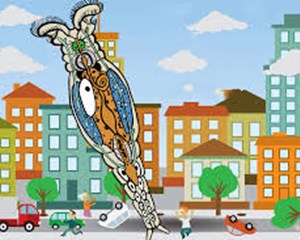Rotifers are famously asexual. The last time members of one group of the animals, the bdelloids, had sex is reckoned by zoologists to have been about 80m years ago. Members of Brachionus plicatilis are not as sex-starved as that, but they still reproduce for the most part by parthenogenesis. Indeed, the variety Dr Abe chose to work with, known as the Notojima strain, is, like the bdelloids, an obligate parthenogen. For this sort of mutagenic work, however, parthenogenesis is an advantage. It means that a successful mutated line of rotifers will not be diluted by the genetic mixing caused by sexual congress.
輪蟲的無性繁殖是出了名的。據動物學家估計,蛭形類動物的最后一次交配發生在大約8000萬年前。褶皺臂尾蟲的成員并沒有那么地“性饑渴”,但它們仍多半通過單性生殖進行繁殖。事實上,安博士選擇研究的品種(被稱為能登品種)就像蛭形蟲一樣是專性單性生殖。然而,對于這種突變工作來說,單性生殖是一種優勢。這意味著一個成功的輪蟲突變系不會被有性繁殖引起的基因混合所稀釋。

The Notojima strain is the largest L rotifer used by Japanese fish farmers. In her quest to make it larger still, Dr Abe exposed batches of the animals to ion beams of various strengths and compositions, and then put the survivors through three rounds of proliferation and selection of the largest of their offspring, to try to come up with the Godzillas of the rotifer world.
日本養魚戶使用的最大的L輪蟲品種是三島品種。為了使其更大,阿部博士將幾批輪蟲暴露在不同強度和組成的離子束當中,然后讓存活下來的輪蟲進行三輪繁殖并選擇其中最大的后代,造出“輪蟲界的哥斯拉”。
The upshot, out of more than 3,000 mutant strains that were larger than normal, was three promising lines which, at 350-370 microns long, nicely plug the size gap, and which are also more fecund than their ancestors. Both of these characteristics make the new strains ideal for use as fish food, and three subsequent years of study have shown them to be stable. Godzilla may be fictional. But the idea that radiation, used carefully, can create animals that are giants of their kind, is not.
結果,在超過3000個比正常突變品種大的突變品種中產生了3個有希望的突變系,它們有350-370微米長,正好填補了大小差距,而且比它們的祖先更多產。這兩種特性使新品種成為了理想的魚食,并且隨后三年的研究表明它們是穩定的。哥斯拉或許是虛構的,但“輻射(謹慎使用)能創造出同類中的巨型怪”這一觀點名副其實。
譯文由可可原創,僅供學習交流使用,未經許可請勿轉載。











